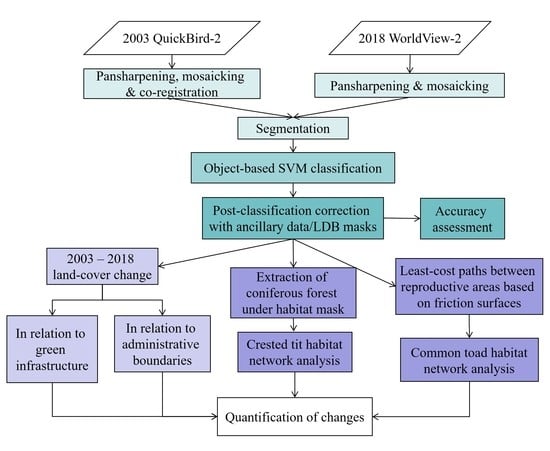Monitoring Urban Green Infrastructure Changes and Impact on Habitat Connectivity Using High-Resolution Satellite Data
Abstract
:1. Introduction
2. Materials and Methods
2.1. Study Area and Data Description
2.2. Methodology
2.2.1. Image Preprocessing
2.2.2. Segmentation and Classification of Satellite Data
2.2.3. Landscape Change Analysis
Land-Cover Change According to Administrative Boundaries and Within the Green Infrastructure
Change in Habitat Network Connectivity
3. Results
3.1. Classification of High-Resolution Satellite Data
3.2. Urban Land-Cover Change and Environmental Impact Analysis
3.2.1. Urban Land-Cover Change at City Level
3.2.2. Land-Cover Change at District Level and within the Green Infrastructure
3.2.3. Changes in Habitat Connectivity and Availability
4. Discussion
5. Conclusions
Author Contributions
Funding
Acknowledgments
Conflicts of Interest
Appendix A
| Criteria | Reference | Parameter Used | |
|---|---|---|---|
| Crested Tit | |||
| Habitat preference | Mature and old pine and spruce forests | [77,94] | Land-cover for habitat patches: coniferous forest |
| Nesting areal requirement | Roughly 2–3 ha | [95] | Patch size minimum: 2 ha |
| Dispersal distance | Several kilometers within habitat but reluctant to cross open spaces | [78,79,80] | Assumed median dispersal/movement distance in urban environment: 200 m |
| Common Toad | |||
| Dispersal distance | Up to 2 km over optimal land-cover but only a few meters over unsuitable land-cover (Table A3) | [96,97,98,99] | Assumed maximum dispersal/movement distance in urban environment: 2 km |
| Habitat | Quality | Biotope/Land-Cover |
|---|---|---|
| Reproductive habitat | Optimal | Wetlands, water with vegetation, streams, water-filled ditches |
| Summer habitat | Optimal | Deciduous forest, mixed forest, moist grassland |
| Suboptimal | Low-density built-up areas with trees/bushes, older coniferous forest, managed grassland | |
| Marginal | Low-density built-up areas without vegetation, young coniferous/mixed forest, heavily managed grassland, agricultural areas | |
| Winter habitat | Optimal | Deciduous forest |
| Suboptimal | Mixed forest, grassland with trees/bushes, low-density built-up areas with trees/bushes | |
| Marginal | Coniferous forest |
| Quality for Dispersal | Biotope/Land-Cover |
|---|---|
| Optimal | Deciduous forest, older coniferous/mixed forest, moist grassland |
| Medium | Low-density built-up areas with trees/bushes, young coniferous/mixed forest |
| Unsuitable | Built-up areas with sealed surfaces, including roads, low-density built-up areas without or with heavily managed vegetation, clear-cut areas |
| Barrier | Buildings, sound berms, steep slopes |
References
- Aronson, M.; LaSorte, F.A.; Nilon, C.H.; Katti, M.; Goddard, M.A.; Lepczyk, C.A.; Warren, P.S.; Williams, W.P.S.; Cilliers, S.; Clarkson, B.; et al. A global analysis of the impacts of urbanization on bird and plant diversity reveals key anthropogenic drivers. Proc. Biol. Sci. 2014, 281, 20133330. [Google Scholar] [CrossRef]
- European Commission. Green Infrastructure (GI)—Enhancing Europe’s Natural Capital. Communication COM 249. 2013. Available online: https://eur-lex.europa.eu/legal-content/EN/TXT/?uri=CELEX:52013DC0249 (accessed on 20 July 2020).
- European Commission. EU Biodiversity Strategy for 2030: Bringing Nature Back into Our Lives. Communication COM 380. 2020. Available online: https://eur-lex.europa.eu/resource.html?uri=cellar:a3c806a6-9ab3-11ea-9d2d-01aa75ed71a1.0001.02/DOC_1&format=PDF (accessed on 3 September 2020).
- Swedish Environmental Protection Agency. Regionala Handlingsplaner för Grön Infrastruktur och Prioritering av Naturvårdsinsatser [Regional Action Plans for Green Infrastructure and Priorization of Nature Conservation Efforts]. 2017. Available online: https://www.naturvardsverket.se/upload/stod-i-miljoarbetet/vagledning/samhallsplanering/Vagledning-GI-naturvardsprioriteringar.pdf (accessed on 20 July 2020). (In Swedish)
- Stockholm County Administrative Board. Grön infrastruktur—Regional Handlingsplan för Stockholms län [Green infrastructure—Regional Action Plan for Stockholm County]. Report December 2019. Available online: https://www.lansstyrelsen.se/download/18.35db062616a5352a22a21fa1/1560332365801/R2019-12%20Gr%C3%B6n%20infrastruktur-Handlingsplan.pdf (accessed on 20 July 2020). (In Swedish)
- Tzoulas, K.; Korpela, K.; Venn, S.; Yli-Pelkonen, V.; Kaźmierczak, A.; Niemela, J.; James, P. Promoting ecosystem and human health in urban areas using Green Infrastructure: A literature review. Landsc. Urban Plan. 2007, 81, 167–178. [Google Scholar] [CrossRef] [Green Version]
- Pauleit, S.; Ambrose-Oji, B.; Andersson, E.; Anton, B.; Buijs, A.; Haase, D.; Elands, B.; Hansen, R.; Kowarik, I.; Kronenberg, J.; et al. Advancing urban green infrastructure in Europe: Outcomes and reflections from the GREEN SURGE project. Urban For. Urban Green. 2019, 40, 4–16. [Google Scholar] [CrossRef]
- Mörtberg, U.; Zetterberg, A.; Brokking Balfors, B. Urban landscapes in transition: Lessons from integrating biodiversity and habitat modelling in planning. J. Environ. Assess. Policy Manag. 2012, 14, 1250002. [Google Scholar] [CrossRef]
- Stockholm City. Översiktsplan för Stockholms stad [Comprehensive plan for the City of Stockholm]. 2018. Available online: https://vaxer.stockholm/globalassets/tema/oversiktsplanen/uppdatering-av-op/godkannade-op/oversiktsplan-for-stockholms-stad-godkannandehandling.pdf (accessed on 20 July 2020). (In Swedish)
- Stockholm City. Hållbar mark-och Vattenanvändning [Sustainable Land and Water Use]. 2019. Available online: http://miljobarometern.stockholm.se/miljomal/miljoprogram-2016-2019/hallbar-mark-och-vattenanvandning/ (accessed on 20 July 2020). (In Swedish)
- Stadsbyggnadskontoret Stockholm city building office. In Proceedings of the Communication within EO&AI4ChangeDetection Project Meeting, Stockholm, Sweden, 10 October 2019.
- Herold, M.; Couclelis, H.; Clarke, K.C. The role of spatial metrics in the analysis and modeling of urban land use change. Comput. Environ. Urban Syst. 2005, 29, 369–399. [Google Scholar] [CrossRef]
- Gamba, P.; Herold, M. Global Mapping of Human Settlement: Experiences, Datasets, and Prospects; CRC Press: Boca Raton, FL, USA, 2009. [Google Scholar]
- Furberg, D.; Ban, Y. Satellite monitoring of urban sprawl and assessment of its potential environmental impact in the greater toronto area between 1985 and 2005. Environ. Manag. 2012, 50, 1068–1088. [Google Scholar] [CrossRef]
- Wang, L.; Li, C.; Ying, Q.; Cheng, X.; Wang, X.; Li, X.; Hu, L.; Liang, L.; Yu, L.; Huang, H.; et al. China’s urban expansion from 1990 to 2010 determined with satellite remote sensing. Chin. Sci. Bull. 2012, 57, 2802–2812. [Google Scholar] [CrossRef] [Green Version]
- Liu, T.; Yang, X. Monitoring land changes in an urban area using satellite imagery, GIS and landscape metrics. Appl. Geogr. 2015, 56, 42–54. [Google Scholar] [CrossRef]
- Haas, J.; Ban, Y. Urban land cover and ecosystem service changes based on sentinel-2a msi and landsat tm data. IEEE J. Sel. Top. Appl. Earth Obs. Remote Sens. 2018, 11, 485–497. [Google Scholar] [CrossRef]
- Ban, Y.; Hu, H.; Rangel, I.M. Fusion of Quickbird MS and RADARSAT SAR data for urban land-cover mapping: Object-based and knowledge-based approach. Int. J. Remote Sens. 2010, 31, 1391–1410. [Google Scholar] [CrossRef]
- Myint, S.W.; Gober, P.; Brazel, A.; Grossman-Clarke, S.; Weng, Q. Per-pixel vs. object-based classification of urban land cover extraction using high spatial resolution imagery. Remote Sens. Environ. 2011, 115, 1145–1161. [Google Scholar] [CrossRef]
- Ma, L.; Li, M.; Ma, X.; Cheng, L.; Du, P.; Liu, Y. A review of supervised object-based land-cover image classification. ISPRS J. Photogramm. Remote Sens. 2017, 130, 277–293. [Google Scholar] [CrossRef]
- Momeni, R.; Aplin, P.; Boyd, D.S. Mapping complex urban land cover from spaceborne imagery: The influence of spatial resolution, spectral band set and classification approach. Remote Sens. 2016, 8, 88. [Google Scholar] [CrossRef] [Green Version]
- Shackelford, A.K.; Davis, C.H. A combined fuzzy pixel-based and object-based approach for classification of high-resolution multispectral data over urban areas. IEEE Trans. Geosci. Remote Sens. 2003, 41, 2354–2363. [Google Scholar] [CrossRef] [Green Version]
- Haas, J.; Ban, Y. Mapping and monitoring urban ecosystem services using multitemporal high-resolution satellite data. IEEE J. Sel. Top. Appl. Earth Obs. Remote Sens. 2017, 10, 669–680. [Google Scholar] [CrossRef]
- Mugiraneza, T.; Nascetti, A.; Ban, Y. WorldView-2 data for hierarchical object-based urban land cover classification in kigali: Integrating rule-based approach with urban density and greenness indices. Remote Sens. 2019, 11, 2128. [Google Scholar] [CrossRef] [Green Version]
- Mutuku, F.M.; Bayoh, M.N.; Hightower, A.W.; Vulule, J.M.; Gimnig, J.E.; Mueke, J.M.; Amimo, F.A.; Walker, E.D. A supervised land cover classification of a western Kenya lowland endemic for human malaria: Associations of land cover with larval Anopheles habitats. Int. J. Health Geogr. 2009, 8, 19. [Google Scholar] [CrossRef] [Green Version]
- Recio, M.R.; Mathieu, R.; Hall, G.B.; Moore, A.B.; Seddon, P.J. Landscape resource mapping for wildlife research using very high resolution satellite imagery. Methods Ecol. Evol. 2013, 4, 982–992. [Google Scholar] [CrossRef]
- Sawaya, K.E.; Olmanson, L.G.; Heinert, N.J.; Brezonik, P.L.; Bauer, M.E. Extending satellite remote sensing to local scales: Land and water resource monitoring using high-resolution imagery. Remote Sens. Environ. 2003, 88, 144–156. [Google Scholar] [CrossRef]
- Mathieu, R.; Freeman, C.; Aryal, J. Mapping private gardens in urban areas using object-oriented techniques and very high-resolution satellite imagery. Landsc. Urban Plan. 2007, 81, 179–192. [Google Scholar] [CrossRef]
- Lang, S.; Blaschke, T.; Kothencz, G.; Hölbling, D. Urban green mapping and valuation. In Urban Remote Sensing, 2nd ed.; Weng, Q., Quattrochi, D., Gamba, P.E., Eds.; CRC Press: Boca Raton, FL, USA, 2018; pp. 287–309. [Google Scholar]
- Lakes, T.; Kim, H.O. The urban environmental indicator “Biotope Area Ratio”—an enhanced approach to assess and manage the urban ecosystem services using high resolution remote-sensing. Ecol. Indic. 2012, 13, 93–103. [Google Scholar] [CrossRef]
- Turner, W.; Rondinini, C.; Pettorelli, N.; Mora, B.; Leidner, A.K.; Szantoi, Z.; Buchanan, G.; Dech, S.; Dwyer, J.; Herold, M.; et al. Free and open-access satellite data are key to biodiversity conservation. Biol. Conserv. 2015, 182, 173–176. [Google Scholar] [CrossRef] [Green Version]
- Pettorelli, N.; Laurance, W.F.; O’Brien, T.G.; Wegmann, M.; Nagendra, H.; Turner, W. Satellite remote sensing for applied ecologists: Opportunities and challenges. J. Appl. Ecol. 2014, 51, 839–848. [Google Scholar] [CrossRef]
- Pettorelli, N.; Safi, K.; Turner, W. Satellite remote sensing, biodiversity research and conservation of the future. Philos. Trans. R. Soc. B 2014, 369, 20130190. [Google Scholar] [CrossRef] [PubMed]
- Mairota, P.; Cafarelli, B.; Didham, R.K.; Lovergine, F.P.; Lucas, R.M.; Nagendra, H.; Rocchini, D.; Tarantino, C. Challenges and opportunities in harnessing satellite remote-sensing for biodiversity monitoring. Ecol. Inform. 2015, 30, 207–214. [Google Scholar] [CrossRef]
- Boyle, S.A.; Kennedy, C.M.; Torres, J.; Colman, K.; Pérez-Estigarribia, P.E.; Noé, U. High-resolution satellite imagery is an important yet underutilized resource in conservation biology. PLoS ONE 2014, 9, e86908. [Google Scholar] [CrossRef]
- Nagendra, H.; Lucas, R.; Honrado, J.P.; Jongman, R.H.; Tarantino, C.; Adamo, M.; Mairota, P. Remote sensing for conservation monitoring: Assessing protected areas, habitat extent, habitat condition, species diversity, and threats. Ecol. Indic. 2013, 33, 45–59. [Google Scholar] [CrossRef]
- Löfvenhaft, K.; Runborg, S.; Sjögren-Gulve, P. Biotope patterns and amphibian distribution as assessment tools in urban landscape planning. Landsc. Urban Plan. 2004, 68, 403–427. [Google Scholar] [CrossRef]
- Hartfield, K.A.; Landau, K.I.; Van Leeuwen, W.J. Fusion of high resolution aerial multispectral and LiDAR data: Land cover in the context of urban mosquito habitat. Remote Sens. 2011, 3, 2364–2383. [Google Scholar] [CrossRef] [Green Version]
- Cleve, C.; Kelly, M.; Kearns, F.R.; Moritz, M. Classification of the wildland–urban interface: A comparison of pixel-and object-based classifications using high-resolution aerial photography. Comp. Environ. Urban Syst. 2008, 32, 317–326. [Google Scholar] [CrossRef]
- Agarwal, S.; Vailshery, L.; Jaganmohan, M.; Nagendra, H. Mapping urban tree species using very high resolution satellite imagery: Comparing pixel-based and object-based approaches. ISPRS Int. J. Geo Inf. 2013, 2, 220–236. [Google Scholar] [CrossRef]
- Qian, Y.; Zhou, W.; Yan, J.; Li, W.; Han, L. Comparing machine learning classifiers for object-based land cover classification using very high resolution imagery. Remote Sens. 2015, 7, 153–168. [Google Scholar] [CrossRef]
- Pande-Chhetri, R.; Abd-Elrahman, A.; Liu, T.; Morton, J.; Wilhelm, V.L. Object-based classification of wetland vegetation using very high-resolution unmanned air system imagery. Eur. J. Remote Sens. 2017, 50, 564–576. [Google Scholar] [CrossRef] [Green Version]
- Fahrig, L. Effects of habitat fragmentation on biodiversity. Annu. Rev. Ecol. Evol. Syst. 2003, 34, 487–515. [Google Scholar] [CrossRef] [Green Version]
- St-Laurent, M.-H.; Dussault, C.; Ferron, J.; Gagnon, R. Dissecting habitat loss and fragmentation effects following logging in boreal forest: Conservation perspectives from landscape simulations. Biol. Conserv. 2009, 142, 2240–2249. [Google Scholar] [CrossRef]
- Hanski, I. Metapopulation models. In Encyclopedia of Ecology; Jorgensen, S.E., Fath, B.D., Eds.; Elsevier: Amsterdam, The Netherlands, 2008; pp. 2318–2325. [Google Scholar]
- Urban, D.; Keitt, T. Landscape connectivity: A graph-theoretic perspective. Ecology 2001, 82, 1205–1218. [Google Scholar] [CrossRef]
- Estrada, E.; Bodin, Ö. Using network centrality measures to manage landscape connectivity. Ecol. Appl. 2008, 18, 1810–1825. [Google Scholar] [CrossRef] [Green Version]
- Bodin, Ö.; Zetterberg, A. MatrixGreen: Landscape Ecological Network Analysis Tool–User Manual. Paper V in Connecting the Dots. Doctoral Thesis, KTH Royal Institute of Technology, Stockholm, Sweden, 2011. [Google Scholar]
- Zetterberg, A.; Mörtberg, U.M.; Balfors, B. Making graph theory operational for landscape ecological assessments, planning, and design. Landsc. Urban Plan. 2010, 95, 181–191. [Google Scholar] [CrossRef]
- Saunders, M.I.; Brown, C.J.; Foley, M.M.; Febria, C.M.; Albright, R.; Mehling, M.G.; Kavanaugh, M.T.; Burfeind, D.D. Human impacts on connectivity in marine and freshwater ecosystems assessed using graph theory: A review. Mar. Freshw. Res. 2016, 67, 277–290. [Google Scholar] [CrossRef] [Green Version]
- Huang, Y.; Huang, J.L.; Liao, T.J.; Liang, X.; Tian, H. Simulating urban expansion and its impact on functional connectivity in the Three Gorges Reservoir Area. Sci. Total Environ. 2018, 643, 1553–1561. [Google Scholar] [CrossRef]
- Saura, S.; Pascual-Hortal, L. A new habitat availability index to integrate connectivity in landscape conservation planning: Comparison with existing indices and application to a case study. Landsc. Urban Plan. 2007, 83, 91–103. [Google Scholar] [CrossRef]
- Saura, S.; Rubio, L. A common currency for the different ways in which patches and links can contribute to habitat availability and connectivity in the landscape. Ecography 2010, 33, 523–537. [Google Scholar] [CrossRef]
- Saura, S.; Estreguil, C.; Mouton, C.; Rodríguez-Freire, M. Network analysis to assess landscape connectivity trends: Application to European forests (1990–2000). Ecol. Indic. 2011, 11, 407–416. [Google Scholar] [CrossRef]
- Pérez-Hernández, C.G.; Vergara, P.M.; Saura, S.; Hernández, J. Do corridors promote connectivity for bird-dispersed trees? The case of Persea lingue in Chilean fragmented landscapes. Landsc. Ecol. 2015, 30, 77–90. [Google Scholar] [CrossRef]
- Herrera, L.P.; Sabatino, M.C.; Jaimes, F.R.; Saura, S. Landscape connectivity and the role of small habitat patches as stepping stones: An assessment of the grassland biome in South America. Biodivers. Conserv. 2017, 26, 3465–3479. [Google Scholar] [CrossRef]
- Diniz, M.F.; Machado, R.B.; Bispo, A.A.; Brito, D. Identifying key sites for connecting jaguar populations in the Brazilian Atlantic Forest. Anim. Conserv. 2018, 21, 201–210. [Google Scholar] [CrossRef]
- Bolliger, J.; Silbernagel, J. Contribution of connectivity assessments to Green Infrastructure (GI). ISPRS Int. J. Geo Inf. 2020, 9, 212. [Google Scholar] [CrossRef] [Green Version]
- Zhang, Z.; Meerow, S.; Newell, J.P.; Lindquist, M. Enhancing landscape connectivity through multifunctional green infrastructure corridor modeling and design. Urban For. Urban Green. 2019, 38, 305–317. [Google Scholar] [CrossRef]
- Perkl, R.; Norman, L.M.; Mitchell, D.; Feller, M.; Smith, G.; Wilson, N.R. Urban growth and landscape connectivity threats assessment at Saguaro National Park, Arizona, USA. J. Land Use Sci. 2018, 13, 102–117. [Google Scholar] [CrossRef]
- Nor, A.N.M.; Corstanje, R.; Harris, J.A.; Grafius, D.R.; Siriwardena, G.M. Ecological connectivity networks in rapidly expanding cities. Heliyon 2017, 3, e00325. [Google Scholar] [CrossRef] [Green Version]
- Stockholm City. Statistical Year-Book of Stockholm 2018; Stockholm City: Stockholm, Sweden, 2018. Available online: https://start.stockholm/globalassets/start/om-stockholms-stad/utredningar-statistik-och-fakta/statistik/arsbok/arsbok_2018.pdf (accessed on 20 July 2020).
- Growth and Regional Planning Administration—GRPA (Tillväxt- och Regionplaneförvaltningen). Regional utvecklingsplan för Stockholmsregionen RUFS 2050 [Regional Development Plan for the Stockholm Region RUFS 2050]. Stockholm County Council. 2018. Available online: http://rufs.se/globalassets/e.-rufs-2050/rufs_regional_utvecklingsplan_for_stockholmsregionen_2050_tillganglig.pdf (accessed on 20 July 2020). (In Swedish).
- Stockholm City Environmental Management Department (Miljöförvaltningen, Stockholms stad). Stockholms Ekologiska Infrastruktur—Bakgrund och Beskrivning av Databas och Karta. [Stockholm’s ecological infrastructure—Background and description of the database and map.]. Version 14 February 2014. Available online: http://miljobarometern.stockholm.se/content/docs/mp15/4/ESBO_Bed%C3%B6mningsgrunder.pdf (accessed on 20 July 2020). (In Swedish)
- Gothnier, M.; Hjorth, G.; Östergård, S. Rapport från ArtArken [Report from the Species Ark]. Stockholms artdata-arkiv. Miljöförvaltningen: Stockholm, Sweden, 1999. Available online: http://miljobarometern.stockholm.se/content/docs/tema/natur/Rapport%20fr%C3%A5n%20ArtArken1999%20publ.pdf (accessed on 20 July 2020). (In Swedish)
- Mörtberg, U.; Zetterberg, A.; Gontier, M. Landskapsekologisk analys i Stockholms stad: Metodutveckling med groddjur som exempel [Landscape Ecological Analysis i Stockholm City: Method Development with Amphibians as an Example]; Miljöförvaltningen: Stockholm, Sweden, 2006; Available online: http://miljobarometern.stockholm.se/content/docs/tema/natur/Habitatverktyg_groddjur_2008.pdf (accessed on 20 July 2020). (In Swedish)
- Mörtberg, U.; Zetterberg, A.; Gontier, M. Landskapsekologisk Analys i Stockholms stad: Habitatnätverk för Eklevande Arter och Barrskogsarter [Landscape Ecological Analysis i Stockholm City: Habitat Networks for Oak-Dependent Species and Coniferous Forest Species]; Miljöförvaltningen: Stockholm, Sweden, 2007. Available online: http://miljobarometern.stockholm.se/content/docs/tema/natur/Habitatverktyg_ek_barrskogsarter_2008.pdf (accessed on 20 July 2020). (In Swedish)
- Zhang, Y. 2008. Pan-sharpening for improved information extraction. In Advances in Photogrammetry, Remote Sensing and Spatial Information Sciences; Li, Z., Chen, J., Baltsavias, E., Eds.; CRC Press: Boca Raton, FL, USA, 2008; Volume 7, Chapter 14; pp. 185–203. [Google Scholar]
- Zhang, Y. Problems in the fusion of commercial high-resolution satellite as well as Landsat 7 images and initial solutions. Int. Arch. Photogramm. Remote Sens. Spat. Inf. Sci. 2002, 34, 587–592. [Google Scholar]
- DigitalGlobe. QuickBird Datasheet. 2014. Available online: https://dgv4-cms-production.s3.amazonaws.com/uploads/document/file/131/QuickBird-DS-QB-Prod.pdf (accessed on 20 July 2020).
- DigitalGlobe. WorldView-2 Datasheet. 2016. Available online: https://dgv4-cms-production.s3.amazonaws.com/uploads/document/file/130/WorldView2-DS-WV2-rev2.pdf (accessed on 20 July 2020).
- Blaschke, T. Object based image analysis for remote sensing. ISPRS J. Photogramm. Remote Sens. 2010, 65, 2–16. [Google Scholar] [CrossRef] [Green Version]
- Chen, G.; Weng, Q. Special issue: Remote sensing of our changing landscapes with Geographic Object-based Image Analysis (GEOBIA). GISci. Remote Sens. 2018, 55, 155–158. [Google Scholar] [CrossRef] [Green Version]
- Trimble Germany GmbH. eCognition Developer 9.2 Reference Book; Document Version 9.2.1; Trimble Germany GmbH: Munich, Germany, 2016. [Google Scholar]
- Swedish Environmental Protection Agency. Nationella marktäckedata 2018 basskikt: Produktbeskrivning [National Land-Cover Data 2018 Basic Layer: Product Description]. Version 2.2; 7 July 2020. Available online: https://gpt.vic-metria.nu/data/land/NMD/NMD_Produktbeskrivning_NMD2018Basskikt_v2_2.pdf (accessed on 20 July 2020). (In Swedish)
- Furberg, D.; Ban, Y.; Nascetti, A. Monitoring of urbanization and analysis of environmental impact in Stockholm with Sentinel-2A and SPOT-5 multispectral data. Remote Sens. 2019, 11, 2408. [Google Scholar] [CrossRef] [Green Version]
- Ulfstrand, S. Foraging niche dynamics and overlap in a guild of passerine birds in a south swedish coniferous woodland. Oecologia 1977, 27, 23–45. [Google Scholar] [CrossRef] [PubMed]
- Alatalo, R.V.; Eriksson, D.; Gustafsson, L.; Larsson, K. Exploitation competition influences the use of foraging sites by tits: Experimental evidence. Ecology 1987, 68, 284–290. [Google Scholar] [CrossRef]
- Hansson, L. Vertebrate distributions relative to clear-cut edges in a boreal forest landscape. Landsc. Ecol. 1994, 9, 105–115. [Google Scholar]
- Rodriguez, A.; Andrén, H.; Jansson, G. Habitat-mediated predation risk and decision making of small birds at forest edges. OIKOS 2001, 95, 383–396. [Google Scholar] [CrossRef]
- Groddjur [Amphibians]. Available online: http://miljobarometern.stockholm.se/natur/arter-och-artgrupper/groddjur/groddjur/ (accessed on 16 July 2020). (In Swedish).
- Grodkollen—grodperspektiv på Stockholms natur [Amphibianwatch—Amphibian Perspectives on Stockholm’s Nature]. Available online: http://grodkollen.se/projekt/ (accessed on 16 July 2020). (In Swedish).
- Saura, S.; Torne, J. Conefor Sensinode 2.2: A software package for quantifying the importance of habitat patches for landscape connectivity. Environ. Modell. Softw. 2009, 24, 135–139. [Google Scholar] [CrossRef]
- Hanski, I.; Ovaskainen, O. The metapopulation capacity of a fragmented landscape. Nature 2000, 404, 755–758. [Google Scholar] [CrossRef]
- Moilanen, A.; Nieminen, M. Simple connectivity measures in spatial ecology. Ecology 2002, 83, 1131–1145. [Google Scholar] [CrossRef]
- Jenness Enterprises. Conefor Inputs, Build 1.0.218. 9 April 2016. Available online: http://www.jennessent.com/arcgis/conefor_inputs.htm (accessed on 20 July 2020).
- Liu, S.; Su, H.; Cao, G.; Wang, S.; Guan, Q. Learning from data: A post classification method for annual land cover analysis in urban areas. ISPRS J. Photogramm. Remote Sens. 2019, 154, 202–215. [Google Scholar] [CrossRef]
- European Commission. EU Guidance on Integrating Ecosystems and their Services into Decision-Making. SWD (2019) 305 final; European Commission: Brussels, Belgium, 2019; Available online: https://ec.europa.eu/environment/nature/ecosystems/pdf/SWD_2019_305_F1_STAFF_WORKING_PAPER_EN_V2_P1_1042629.PDF (accessed on 1 September 2020).
- City of Stockholm. Proposed Program for Monitoring Biodiversity and Related Ecosystem Services 2017–2021; Dnr: 2016–16202; Stockholm City Environmental Management Department (Miljöförvaltningen, Stockholms stad): Stockholms, Sweden, 2017. Available online: https://insynsverige.se/documentHandler.ashx?did=1864151 (accessed on 3 September 2020). (In Swedish)
- Wellmann, T.; Lausch, A.; Andersson, E.; Knapp, S.; Cortinovis, C.; Jache, J.; Scheuer, S.; Kremer, P.; Mascarenhas, A.; Kraemer, R.; et al. Remote sensing in urban planning: Contributions towards ecologically sound policies? Landsc. Urban Plan. 2020, 204, 103921. [Google Scholar] [CrossRef]
- Kopecká, M.; Szatmári, D.; Rosina, K. Analysis of urban green spaces based on sentinel-2A: Case studies from slovakia. Land 2017, 6, 25. [Google Scholar] [CrossRef] [Green Version]
- Nichol, J.; Lee, C.M. Urban vegetation monitoring in Hong Kong using high resolution multispectral images. Int. J. Remote Sens. 2005, 26, 903–918. [Google Scholar] [CrossRef]
- Tigges, J.; Lakes, T.; Hostert, P. Urban vegetation classification: Benefits of multitemporal RapidEye satellite data. Remote Sens. Environ. 2013, 136, 66–75. [Google Scholar] [CrossRef]
- Alatalo, R.V.; Gustafsson, L.; Linden, M.; Lundberg, A. Interspecific competition and niche shifts in tits and the goldcrest: An experiment. J. Anim. Ecol. 1985, 54, 977–984. [Google Scholar] [CrossRef]
- Eggers, S. Personal Communication with U. Mörtberg; Swedish University of Agricultural Sciences: Uppsala, Sweden, 2006. [Google Scholar]
- Reading, C.J.; Loman, J.; Madsen, T. Breeding pond fidelity in the common toad, Bufo bufo. J. Zool. 1991, 225, 201–211. [Google Scholar] [CrossRef]
- Andrén, C. Personal Communication with U. Mörtberg; University of Gothenburg: Gothenburg, Sweden, 2005. [Google Scholar]
- Loman, J. Personal Communication with U. Mörtberg; University of Lund: Lund, Sweden, 2005. [Google Scholar]
- Sjögren-Gulve, P. Personal Communication with U. Mörtberg; Swedish Environmental Protection Agency: Stockholm, Sweden, 2005.
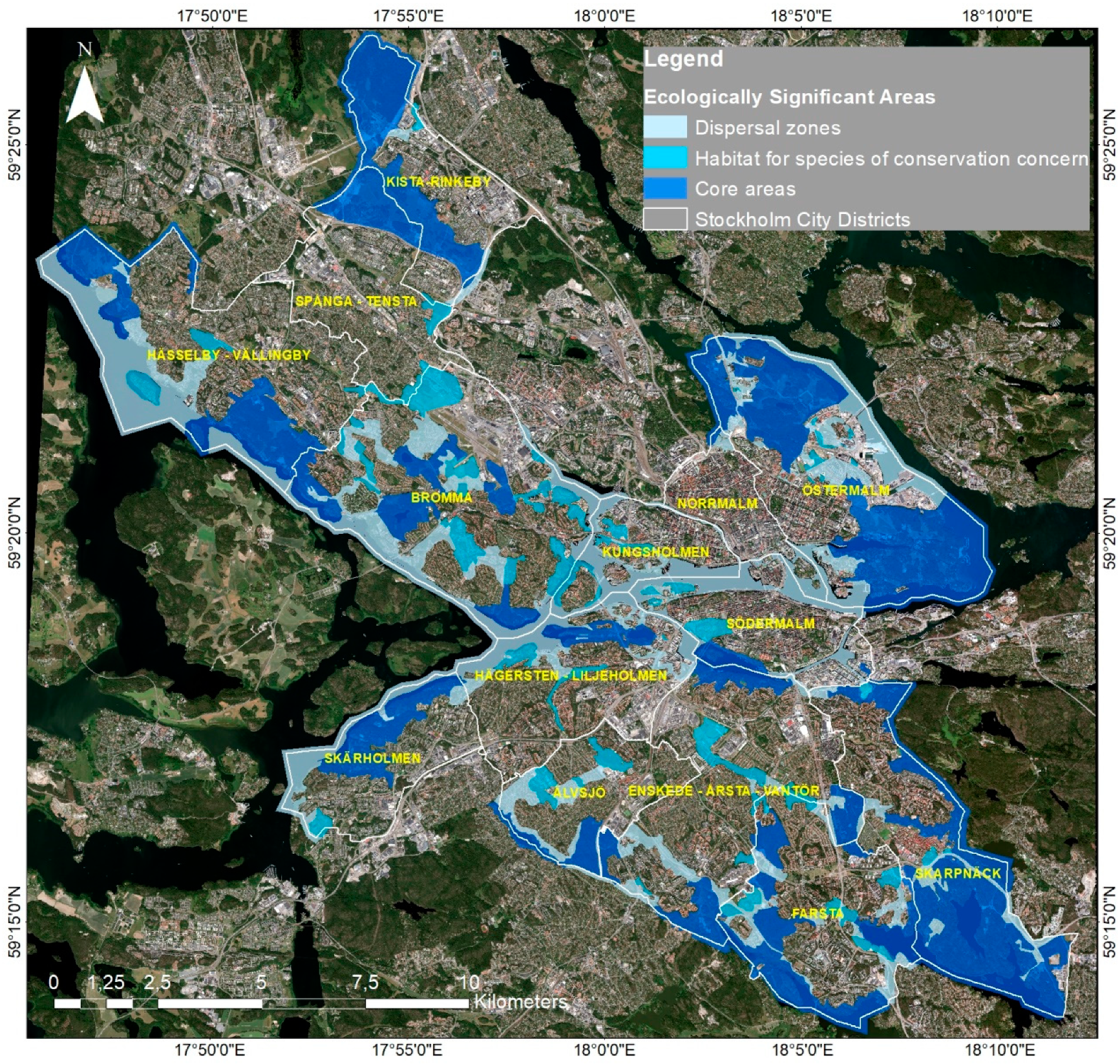

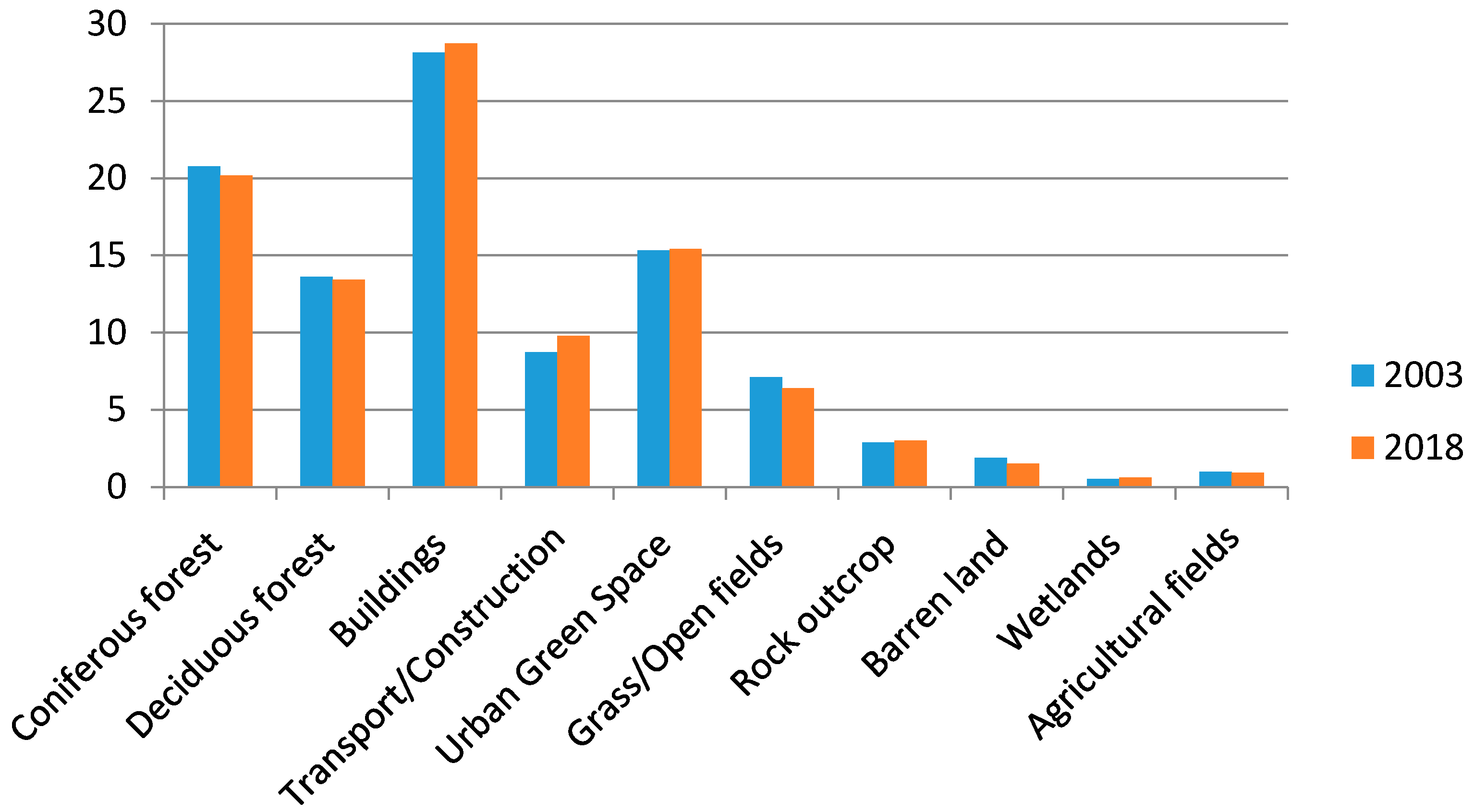

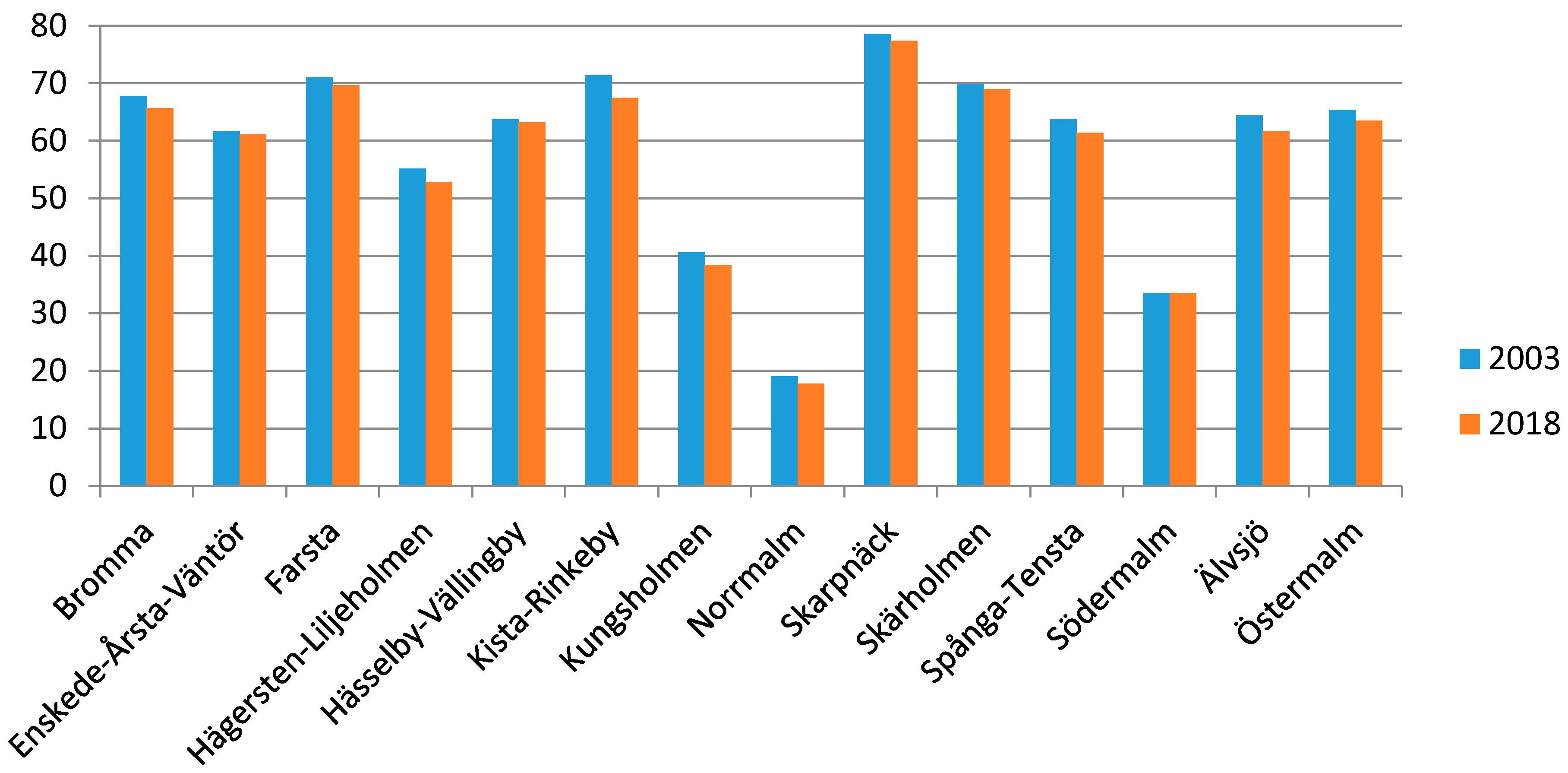


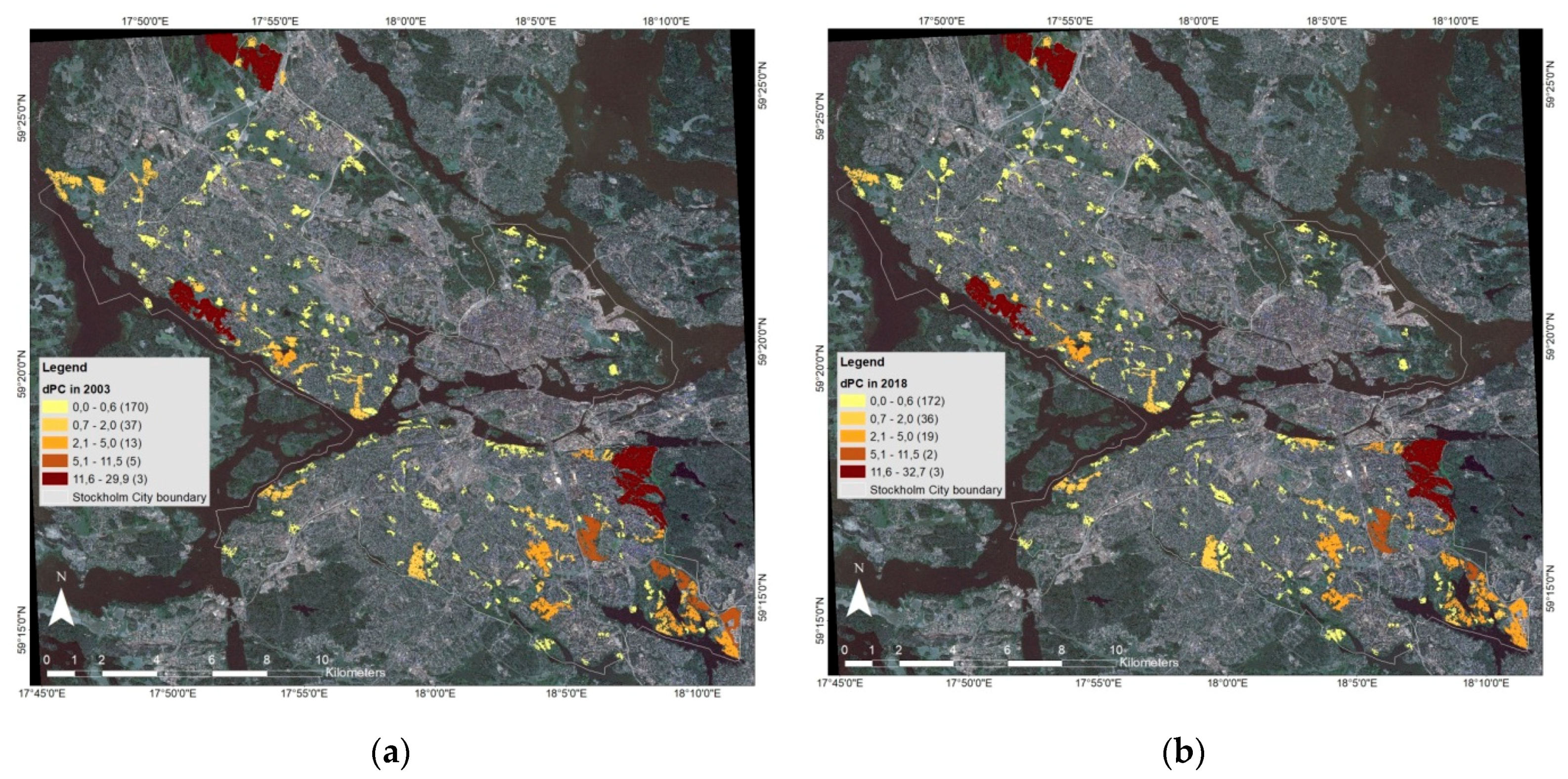
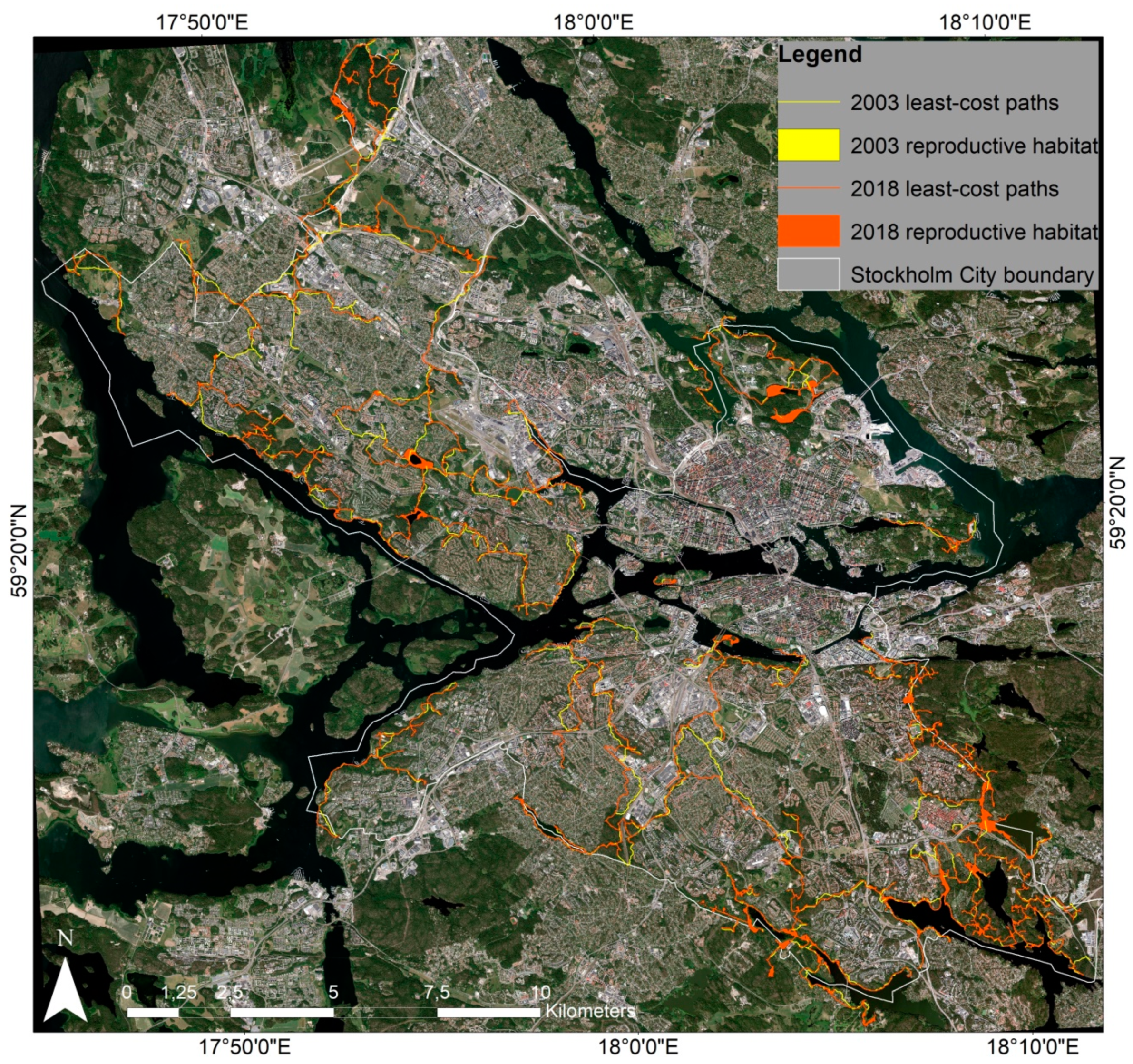


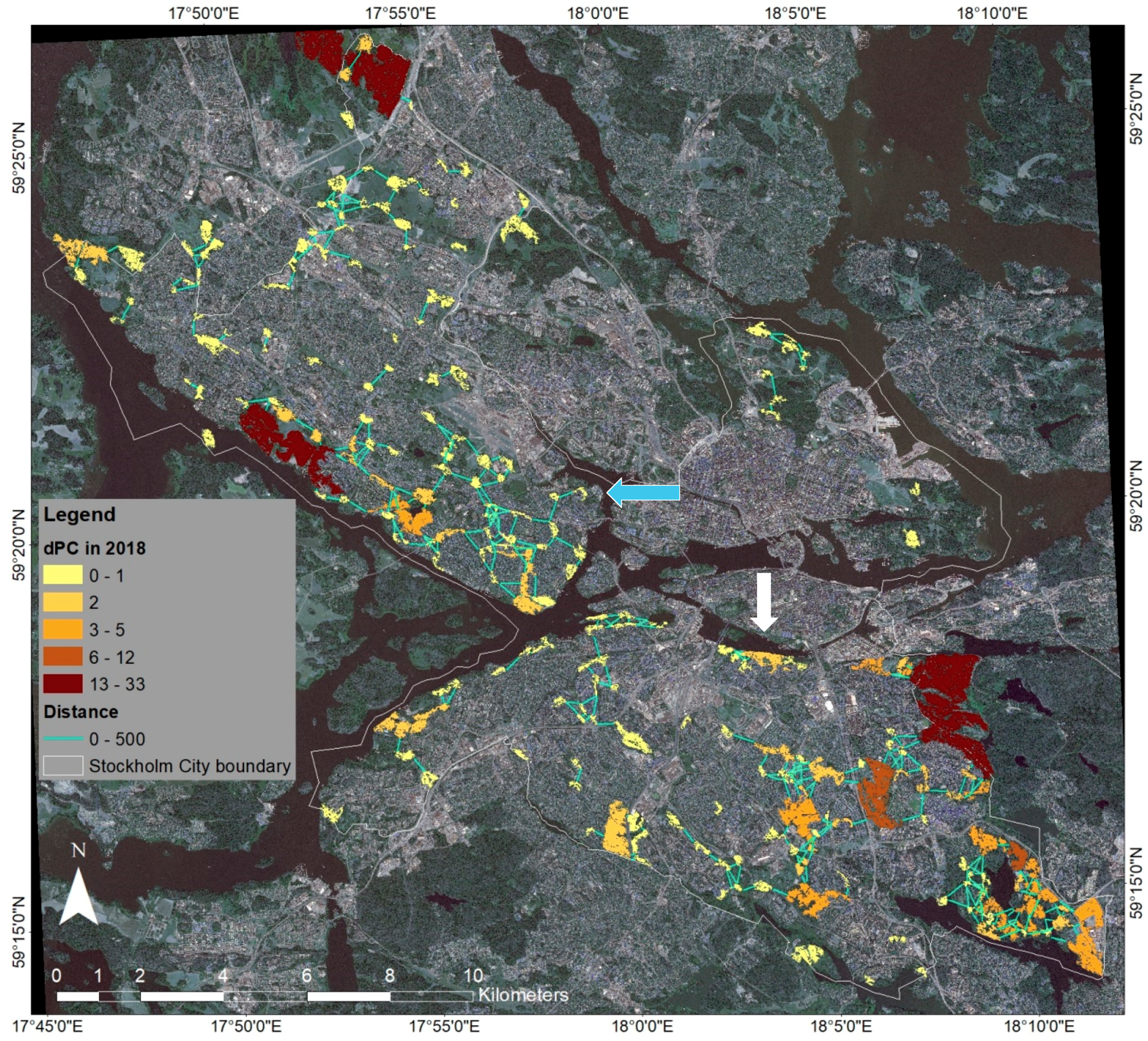
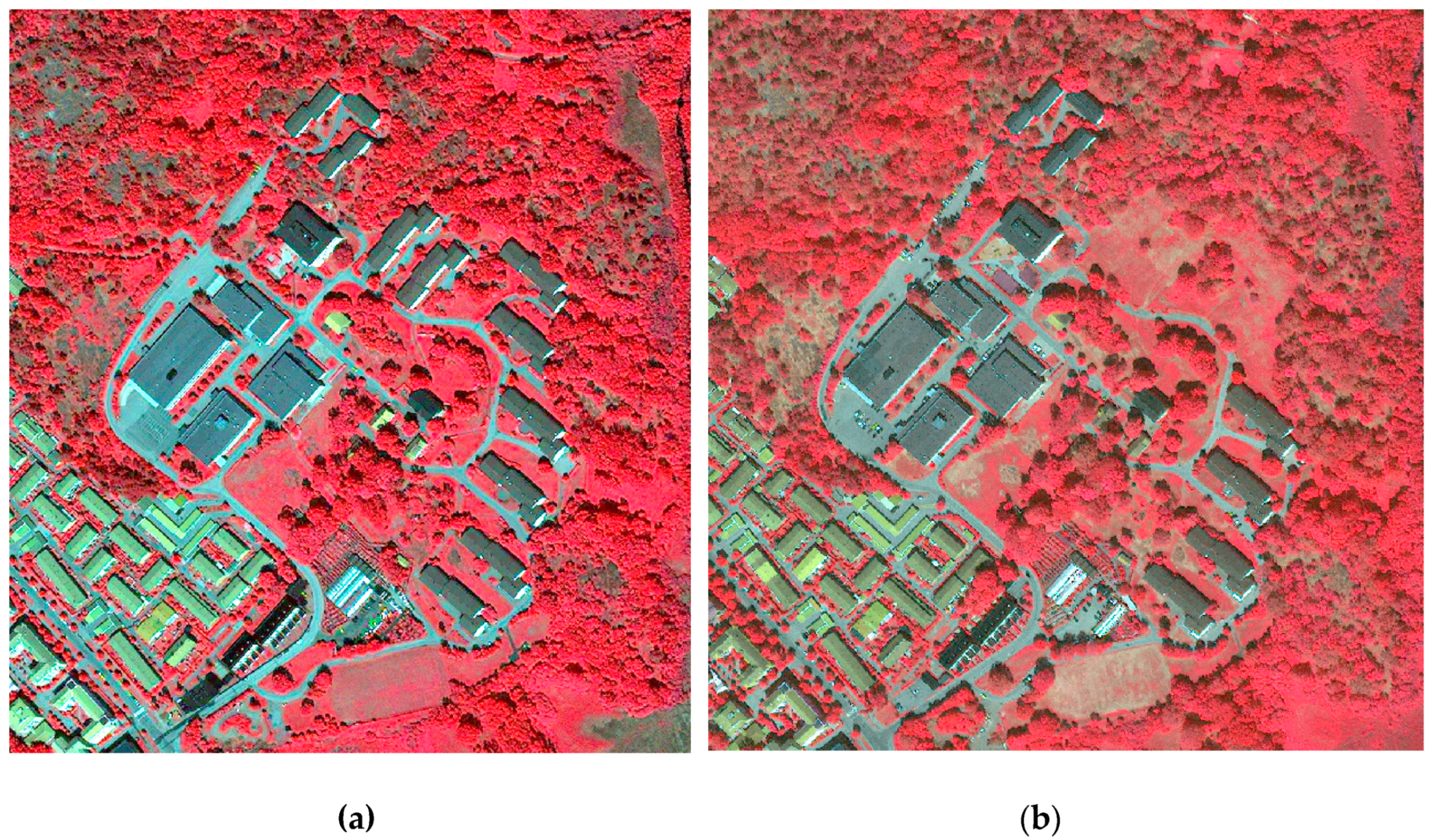
| 2006 | 2003 and 2018 | |
|---|---|---|
| Buildings | 10000 (building edge), 100 (interior) | 10000 |
| Transport/construction (roads) | 50, 100, 200, 10000 | 500 |
| Barren land | 90 | 100 |
| Bare rock | 50 | 50 |
| Urban green space | 30, 40, 50 | 40 |
| Agriculture | 25 | 30 |
| Grassland | 15, 25 | 20 |
| Coniferous forest | 10, 20 | 10 |
| Deciduous forest | 5 | 5 |
| Wetlands | 10, 20, 40 | 1 |
| Water | 0–150 m from shore friction gradient that increases exponentially with increased distance, from 1 to 10000 | |
| 2003 QuickBird-2 | 2018 WorldView-2 | |||
|---|---|---|---|---|
| PA | UA | PA | UA | |
| Buildings | 94.8 | 83.4 | 95.4 | 84.4 |
| Transport/Construction | 85.6 | 85.3 | 87.1 | 88.6 |
| Barren Land | 82.3 | 97.4 | 86.0 | 97.9 |
| Grassland/Sports Fields | 98.8 | 96.1 | 89.7 | 92.0 |
| Urban Green Space | 90.1 | 92.5 | 88.4 | 88.7 |
| Coniferous Forest | 98.8 | 92.6 | 96.6 | 86.5 |
| Deciduous Forest | 95.0 | 97.0 | 88.1 | 94.2 |
| Water | 99.8 | 100.0 | 99.1 | 99.7 |
| Bare Rock | 91.3 | 98.0 | 91.1 | 95.1 |
| Overall Accuracy: | 93.0% | 91.5% | ||
| Overall Kappa Statistic: | 0.92 | 0.90 | ||
| City District | Urban Growth in Hectares | City District | Percentage Loss of Green Area |
|---|---|---|---|
| Bromma | 53.9 | Kista-Rinkeby | −3.95 |
| Kista-Rinkeby | 47.1 | Älvsjö | −2.76 |
| Östermalm | 39.0 | Spånga-Tensta | −2.40 |
| Spånga-Tensta | 31.1 | Hägersten-Liljeholmen | −2.34 |
| Hägersten-Liljeholmen | 30.8 | Kungsholmen | −2.16 |
| Farsta | 26.6 | Bromma | −1.40 |
| Älvsjö | 25.4 | Östermalm | −1.85 |
| Skarpnäck | 19.6 | Farsta | −1.40 |
| Enskede-Årsta-Vantör | 13.8 | Norrmalm | −1.23 |
| Kungsholmen | 12.0 | Skarpnäck | −1.21 |
| Hässelby-Vällingby | 10.1 | Hässelby-Vällingby | −0.56 |
| Norrmalm | 7.6 | Skärholmen | −0.79 |
| Skärholmen | 7.3 | Enskede-Årsta-Vantör | −0.63 |
| Södermalm | 3.1 | Södermalm | −0.10 |
| Green Infrastructure Type | Hectares Converted | Urban Area Increase (%) |
|---|---|---|
| Habitat for Species of Conservation Concern | 13 | 14 |
| Core Areas | 18 | 11 |
| Dispersal Zones | 28 | 6 |
| Year | PC | ECA (ha) | dA | dECA |
|---|---|---|---|---|
| 2003 | 0.06% | 530 | –3% | –4% |
| 2018 | 0.05% | 508 |
| Year | PC | ECA (ha) | dA | dECA |
|---|---|---|---|---|
| 2003 | 0.00042% | 44.3 | −1.6% | −0.03% |
| 2018 | 0.00042% | 44.1 |
| dPCintra | dPCflux | dPCconnector | |
|---|---|---|---|
| (a) | |||
| 2003 | 26% | 50% | 24% |
| 2018 | 28% | 49% | 23% |
| Difference | 2.2% | −0.9% | −1.3% |
| (b) | |||
| 2003 | 92.2% | 7.6% | 0.16% |
| 2018 | 93.0% | 6.8% | 0.18% |
| Difference | 0.8% | −0.9% | 0.02% |
© 2020 by the authors. Licensee MDPI, Basel, Switzerland. This article is an open access article distributed under the terms and conditions of the Creative Commons Attribution (CC BY) license (http://creativecommons.org/licenses/by/4.0/).
Share and Cite
Furberg, D.; Ban, Y.; Mörtberg, U. Monitoring Urban Green Infrastructure Changes and Impact on Habitat Connectivity Using High-Resolution Satellite Data. Remote Sens. 2020, 12, 3072. https://doi.org/10.3390/rs12183072
Furberg D, Ban Y, Mörtberg U. Monitoring Urban Green Infrastructure Changes and Impact on Habitat Connectivity Using High-Resolution Satellite Data. Remote Sensing. 2020; 12(18):3072. https://doi.org/10.3390/rs12183072
Chicago/Turabian StyleFurberg, Dorothy, Yifang Ban, and Ulla Mörtberg. 2020. "Monitoring Urban Green Infrastructure Changes and Impact on Habitat Connectivity Using High-Resolution Satellite Data" Remote Sensing 12, no. 18: 3072. https://doi.org/10.3390/rs12183072
APA StyleFurberg, D., Ban, Y., & Mörtberg, U. (2020). Monitoring Urban Green Infrastructure Changes and Impact on Habitat Connectivity Using High-Resolution Satellite Data. Remote Sensing, 12(18), 3072. https://doi.org/10.3390/rs12183072





